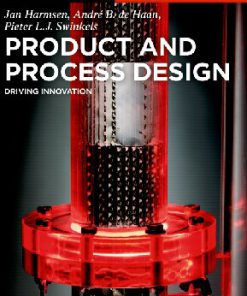Innovation Management 1st Edition by Jan Van Den Ende ISBN 9781352012446 1352012421
$50.00 Original price was: $50.00.$25.00Current price is: $25.00.
Innovation Management 1st Edition by Jan Van Den Ende – Ebook PDF Instant Download/Delivery: 9781352012446 ,1352012421
Full download Innovation Management 1st Edition after payment

Product details:
ISBN 10: 1352012421
ISBN 13: 9781352012446
Author: Jan Van Den Ende
Innovation Management 1st Edition Table of contents:
Part 1 Introduction
1 Innovation management and new business development
Learning objectives
1.0 Introduction
1.1 What are innovation management and new business development?
CASE 1.1 ING: TRANSFORMING A BANK
CASE 1.2 NEW BUSINESS DEVELOPMENT BY BMW AND SIXT: DRIVENOW
Definitions
The innovator
1.2 Paradoxes of innovation
1.3 What is business model innovation?
The Business Model Canvas
Types of business models
Why business models are not the same as strategy
1.4 Types and classifications of innovations
1.5 Innovation and society
The economy
Innovation for society
CASE 1.3 INNOVATION TO HELP SOLVE THE COVID-19 CRISIS
Public policy
Innovativeness of countries
1.6 Summary
1.7 Discussion questions and exercises
Discussion questions
Exercises
References
Part 2 Idea development
2 The front end of innovation
Learning objectives
2.0 Introduction
2.1 Creativity
Knowledge and problems
CASE 2.1 CREATIVITY IN RESPONSE TO AN URGENT NEED: SOUTHWEST
Human creativity
CASE 2.2 THE ROLE OF KNOWLEDGE IN CREATIVITY
Thinking styles
SUMMARIZING SO FAR
2.2 Sources of ideas
Trends as drivers
CASE 2.3 TRENDS AS DRIVER OF COMPUTING INNOVATIONS
Business and social networks
2.3 Tools for creativity
2.4 Scenario workshops
CASE 2.4 SCENARIO DEVELOPMENT FOR THE DREDGING INDUSTRY
2.5 Leading creativity workshops
Conditions for a successful creativity workshop
2.6 Managing the internal front end
CASE 2.5 GAMECHANGER
CASE 2.6 IDEA CATALYSTS AT IBM
2.7 Crowdsourcing ideas
CASE 2.7 CROWDSOURCING AT P&G
CASE 2.8 INNOCENTIVE
2.8 Summary
2.9 Discussion questions and exercises
Discussion questions
Exercises
References
3 Design thinking
Learning objectives
3.0 Introduction
3.1 Processes to involve customers
Should customers be involved?
CASE 3.1 THE SOCIAL CONSTRUCTION OF WHEEL CLAMPS
CASE 3.2 DESIGN THINKING: IDEO DEVELOPS A SHOPPING CART
CASE 3.3 THE SOLUTION SPACE OF GERONIMO.AI
Design thinking
Lean innovation
The solution space
3.2 The customer study phase
Traditional marketing techniques
CASE 3.4 OBSERVATION: DEVELOPMENT OF A TOOTHBRUSH BY IDEO
Methods for more radical innovation
Crowdsourcing from customers
Data analytics
3.3 Market learning in the testing phase
Lean innovation and discovery-driven planning
Co-creation with customers
CASE 3.5 PHILIPS HOME LAB
CASE 3.6 CO-CREATION FOR DUTCH BLEND
Testing during implementation and real market tests
CASE 3.7 MARKET LEARNING BY ING DIRECT
3.4 When to use which method
3.5 Design-driven innovation
3.6 Summary
3.7 Discussion questions and exercises
Discussion questions
Exercises
References
Part 3 Selection
4 Innovation strategy
Learning objectives
4.0 Introduction
4.1 Creating an innovation strategy
What is an innovation strategy?
4.2 Life cycles of products, services and knowledge
Life cycles
CASE 4.1 ALTERNATIVE NAMES FOR SMARTPHONES
CASE 4.2 DESIGN BATTLE IN ALTERNATIVE ENERGY CARS
CASE 4.3 WHY WE USE THE QWERTY KEYBOARD
CASE 4.4 DURATION OF SUCCESSIVE LIFE CYCLES OF BICYCLES
Knowledge life cycles and the dynamics of firms
CASE 4.5 EFFECTS OF DNA TECHNOLOGY KNOWLEDGE ON PRODUCT LIFE CYCLES
CASE 4.6 THE DYNAMICS OF PHILIPS OVER TIME
CASE 4.7 THE EFFECTS OF KNOWLEDGE DEVELOPMENT ON COMPANY DYNAMICS: GOOGLE
4.3 Disruptive innovation
CASE 4.8 RYANAIR: A DISRUPTIVE INNOVATION
CASE 4.9 DISRUPTIVE INNOVATION IN THE NEWSPAPER MARKET
CASE 4.10 DISRUPTIVE INNOVATION IN A SHIPBUILDING COMPANY
4.4 Timing of innovation
CASE 4.11 FIRST MOVER DISADVANTAGES: LAKER AIRWAYS
4.5 Ecosystem innovation
CASE 4.12 THE ECOSYSTEM OF THE MICHELIN RUN-FLAT TYRE
CASE 4.13 THE FAILURE OF BETTER PLACE
CASE 4.14 IBM LOSES CONTROL OF ITS PERSONAL COMPUTER
CASE 4.15 ECOSYSTEM ORCHESTRATION FOR A SUSTAINABLE INNOVATION
4.6 Strategy in a networked market
CASE 4.16 NETWORK EFFECTS IN MICROSOFT’S HISTORY
What is a networked market?
CASE 4.17 FRYING PRODUCTS: LOW NETWORK EFFECTS
Two-sided and other platforms
Who wins?
Standardization
4.7 Intellectual property
Patents
CASE 4.18 HOW DONALD DUCK BLOCKED A PATENT
CASE 4.19 PATENT BATTLES BETWEEN APPLE AND SAMSUNG
Copyrights
CASE 4.20 BLURRED LINES VERSUS GOT TO GIVE IT UP
Trademarks
Secrecy
Open-source strategies
4.8 Summary
4.9 Discussion questions and exercises
Discussion questions
Exercises
References
5 Portfolio management
Learning objectives
5.0 Introduction
5.1 Reactive versus proactive portfolio management
Proactive portfolio management in small or medium-sized firms (SMEs)
CASE 5.1 RADICAL INNOVATION FOR SMEs
Proactive portfolio management in large firms
CASE 5.2. DIMINISHING OPPORTUNITIES IN DRUG MARKETS
CASE 5.3 CHANGING CATEGORIES OVER TIME IN THE CAR INDUSTRY
CASE 5.4 PORTFOLIO MANAGEMENT AND THE FALL OF NOKIA
5.2 Platform and modular design
CASE 5.5 MODULARITY IN WEB-SHOP AND CAR-SHARING SERVICES
5.3 Managing the decision process
CASE 5.6 NESPRESSO: PATIENCE TO WAIT FOR SUCCESS
Resistance and status in project decisions
5.4 Tools for portfolio management
Financial method: NPV
Real options
CASE 5.7 REAL OPTIONS APPROACH FOR AN INTERNATIONALIZATION PROJECT
CASE 5.8 SETTING UP A CHAIN OF CHARGING STATIONS FOR ELECTRIC CARS
Software tools
5.5 Summary
5.6 Discussion questions and exercises
Discussion questions
Exercises
References
Part 4 Implementation
6 Managing projects
Learning objectives
6.0 Introduction
6.1 Uncertainty and process models
CASE 6.1 THE ‘TRAIN SCHEDULE’: REDUCING DELAYS IN PROJECTS AT MEDTRONIC
6.2 Process models
Sequential models
Parallel models
CASE 6.2 THE INNOVATION PROCESS MODEL OF MICROSOFT
Iterative processes
CASE 6.3 THE VALUE OF A MARKET TEST: KELLY SLATER’S PRO SURFER GAME
CASE 6.4 PROBLEMS OF INFORMATION EXCHANGE IN A LARGE INNOVATION PROJECT
Does agile work?
6.3 The business plan
6.4 Project management
CASE 6.5 AMBIGUITY IN THE CASE OF RIMONABANT
Alignment with the innovation process
6.5 Control of innovation projects
CASE 6.6 THE USE OF OUTCOME INDICATORS FOR A MARGARINE PROJECT AT UNILEVER
6.6 Summary
6.7 Discussion questions and exercises
Discussion questions
Exercises
References
7 Organizing for innovation
Learning objectives
7.0 Introduction
7.1 Team structures
Flexibility and external relations
CASE 7.1 THE INFLUENCE OF TEAM COMPOSITION IN AN AUTONOMOUS TEAM
Representations of the concept
CASE 7.2 JIBO: DESIGNING A SOCIAL ROBOT
7.2 Organizing innovation at the firm level
Option 1: Separate business unit
Ventures and spin offs
Option 2: Innovation unit
CASE 7.3 PROS AND CONS OF A SEPARATE UNIT IN A BANK
Option 3: Innovation manager
Option 4: Integrated in the business
CASE 7.4 INTEGRATION OF NEW BUSINESS DEVELOPMENT IN AN ENGINEERING COMPANY
Comparison of options
CASE 7.5 COMPETITION BETWEEN THE INNOVATION LAB AND EXISTING BUSINESS UNITS
Team structures and organizational structures
Organizing for innovation in the rest of the company
Social networks
7.3 Leadership
Team leadership
Getting support
Organizational identity
7.4 Knowledge for innovation and new business development
The need for knowledge
7.5 Culture of innovation
7.6 Summary
7.7 Discussion questions and exercises
Discussion questions
Exercises
References
8 Open innovation
Learning objectives
8.0 Introduction
8.1 Acquiring knowledge and innovation
CASE 8.1 ACQUISITION OF DOLLAR SHAVE CLUB BY UNILEVER
8.2 Collaboration between firms
Why collaborate? Capabilities
CASE 8.2 INTEGRALITY IN THE DESIGN OF THE LOGISTIC PROCESS OF A WEB-SHOP
Why collaborate? Low interdependence
CASE 8.3 THE MIRRORING HYPOTHESIS IN BMW
Other reasons to collaborate
8.3 How to collaborate
Coordination of tasks
CASE 8.4 PROBLEMS IN A COLLABORATION PROJECT DUE TO UNCERTAINTY
Contracts
Trust
8.4 Collaborating with start-ups and selling off innovation
Corporate incubators
CASE 8.5 CORPORATE INCUBATOR AT AN ENERGY COMPANY
Spinning off innovations
CASE 8.6 THE VALUE OF BUSINESSES OF DEPARTED EMPLOYEES FROM XEROX
Licensing out technology
8.5 Integration and disintegration in supply chains
CASE 8.7 INTEGRATION IN THE SUPPLY CHAIN OF NAVIGATION PRODUCTS
CASE 8.8 RESEARCH INTENSITY AND HORIZONTAL INTEGRATION IN THE PLANT BREEDING SECTOR
8.6 Innovation clusters
CASE 8.9 THE ORIGINS OF SILICON VALLEY
CASE 8.10 THE INNOVATION CAMPUS AT AACHEN (GERMANY)
8.7 Summary
8.8 Discussion questions and exercises
Discussion questions
Exercises
References
Part 5 Innovation in specific types of firms
9 Entrepreneurship
Learning objectives
9.0 Introduction
9.1 Start-ups and innovation
What types of innovations do start-ups create?
CASE 9.1 RED BULL: HOW A START-UP ATTACKS A MARKET OF LARGE ESTABLISHED COMPANIES
Survival rates
9.2 Who becomes an entrepreneur?
9.3 The entrepreneurial process
Team formation
CASE 9.2 SIREN CARE: HOW THE FOUNDING TEAM REFLECTS THE REQUIRED EXPERTISE
CASE 9.3 X2AI: HOW ENTREPRENEURS FIND EACH OTHER
Marketing and sales
Scaling up
Financing the start-up
Valuation
Bootstrapping
CASE 9.4 HEALTHTAP, WITH ANGEL INVESTOR ERIC SCHMIDT
9.4 Incubators
CASE 9.5 INCUBATORS OF THE SPACE ORGANIZATION ESA
9.5 Summary
9.6 Discussion questions and exercises
Discussion questions
Exercises
References
10 Innovation in project-based and multinational firms
Learning objectives
10.0 Introduction
10.1 Innovation in project-based firms
How do project-based firms innovate?
How to run innovation projects
CASE 10.1 COORDINATION OF INNOVATION IN AN ENGINEERING COMPANY
Innovation in health care
10.2 Innovation in multinationals
International innovation strategies
CASE 10.2 INTERNATIONALIZATION OF LIQUID MARGARINE
Frugal innovation
International organization
CASE 10.4 SERVITIZATION FOR LIFE RAFTS: WILHEMSEN
10.3 Servitization: adding services to products
CASE 10.3 XEROX AND THE SERVICE BUSINESS MODEL
10.4 Summary
10.5 Discussion questions and exercises
Discussion questions
Exercises
References
Part 6 Conclusion
11 The future of innovation management and new business development
Learning objectives
11.0 Introduction
11.1 Innovation in practice
11.2 The origins of the field
11.3 Towards a theory of innovation management and new business development
The process perspective
The people perspective
The strategy perspective
How to combine perspectives
11.4 Summary
11.5 Discussion questions
People also search for Innovation Management 1st Edition:
technological innovation management and entrepreneurship vtu notes
tu darmstadt entrepreneurship and innovation management
technology leadership and innovation management
technology and innovation management harz
technology and innovation management pdf
You may also like…
Politics & Philosophy - General & Miscellaneous Philosophy
Uncategorized
Operations Management for Healthcare 2nd Edition by Jan, Sylvia, Nathan 9780367895952 0367895951
Commercial & Financial Law
Arts - Film
Religion & Spirituality
Uncategorized
Mathematics - Functional Analysis











